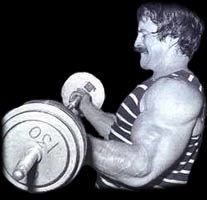-
Strength - 1 - 5 repetitions per set
Muscle Mass - 6 - 10 repetitions per set
Muscle Mass for slow twitch fibers - 12 - 20 or more reps per set such as thighs and calves, and for some this still includes the outdated notion of high reps for definition.
There are some problems with this general thinking. First, muscles don't count reps, so these numbers could be completely different for someone who takes 10 seconds to complete one rep, compared to someone who takes 2 seconds for each rep.

Misapplication Of Reps

 A good example of this misapplication is recommendations by the late Mike Mentzer. Mike usually recommended 6 to 10 reps per set. People then got the notion that Heavy Duty was about lifting extremely heavy weights but in truth this was not the case. Mike advocated rep speeds that took about 10 seconds to complete each rep.
A good example of this misapplication is recommendations by the late Mike Mentzer. Mike usually recommended 6 to 10 reps per set. People then got the notion that Heavy Duty was about lifting extremely heavy weights but in truth this was not the case. Mike advocated rep speeds that took about 10 seconds to complete each rep.
For 6 reps, that's 60 seconds of TUL. However, the way most people perform reps, that's only about 12 - 18 seconds.
That's a huge difference, which would result in a huge difference in weight used and probably a big difference in the progress the trainee made.
This is a very important part of this concept that has gotten lost over the years. When studies were done that showed 8 - 12 repetitions was the optimal number of reps in a set for most people, the accepted cadence was 2 seconds for the raising (positive) part of the rep and 4 seconds (negative) for the lowering of the weight.
Each repetition took 6 seconds to complete for a total rep time of 48 - 72 seconds for the entire set. This is a vital fact of exercise physiology to understand if you wish to optimize your progress.

Muscles Don't Count Reps!

All they know is what's known as Time Under Tension (TUT), or Time Under Load (TUL). TUT and TUL can be used interchangeably.
While weight training to add muscle mass, muscle tension beyond a certain point, and maintained within a certain time frame (without moving into aerobic territory), causes the chemical reactions in the muscle that triggers the adaptive response. With enough rest before the next workout, this allows the muscle to over compensate and grow larger and stronger.
The amount of tension or load placed on the muscle, and the amount of time the muscle can maintain that tension are inversely proportional. Does that sound familiar? Yes, once again, to add muscle, you must work out harder, not longer.
You need to use enough tension to keep your body from using its aerobic power, but not so much tension that you don't keep the muscle under tension long enough to elicit a positive anaerobic reaction.
This is where the 8 - 12 repetition guide came from. The problem is that the repetition guide was born out of the recommended time under load, not the other way around. Eventually, the 8 - 12 reps were always prescribed, and the time under load fell by the way side.
Unfortunately, it was the time under load recommendation of 48 - 72 seconds per set that was the reason the 8 - 12 reps were effective. Next time you go to the gym to workout, pay attention to the rep speed of the vast majority of people in your gym.

In The Gym...

You will find two things. One, almost no one counts the time under load, or rep speed. And the rep speed of the majority of trainees is about 1 second up and 1 second down.
 For a set of 8 - 12 reps, most of them have a time under load of about 16 - 36 seconds, at most. This is far below the effective recommendation.
For a set of 8 - 12 reps, most of them have a time under load of about 16 - 36 seconds, at most. This is far below the effective recommendation.
The only way to accurately measure progress, and to ensure that you are keeping the muscle under adequate tension, is to use seconds to measure time under tension, and not number of repetitions.
Excluding such things as mental effort, fast twitch fibers respond best with a tension time of approximately 40 - 50 seconds. Slow twitch (more endurance oriented) respond best with a tension time of 90 - 120 seconds, while a mixture of the two does well with a time under load of approximately 50 - 90 seconds.
As you can see, most trainees today use load times well below the most effective tension times for inducing a positive response in their body. They also ignore the fact that the ideal time under tension (or number of reps), most likely varies from muscle to muscle within the same individual.
In addition, they compound the problem by trying to make up for this by adding more and more sets. All they end up doing is cutting into the muscles recovery time and never allowing it to over compensate and grow larger and stronger.
The time under tension or number of reps per set that is appropriate for you is also affected by your muscle fiber make up and your neuromuscular efficiency.
In simple terms, the faster a muscle fatigues, the higher its neuromuscular efficiency (ability to contract a large number of fibers at one time), and the greater the muscle's fast twitch fiber content.
The slower the muscle fatigues, the lower it's neuromuscular efficiency, and the greater the number of slow twitch fibers.
These are vital factors when determining the appropriate number of reps, or time under tension, that is needed for a body part to induce optimal (or any) results from your training.
Building Muscle & Burning Fat!
Thanks,
